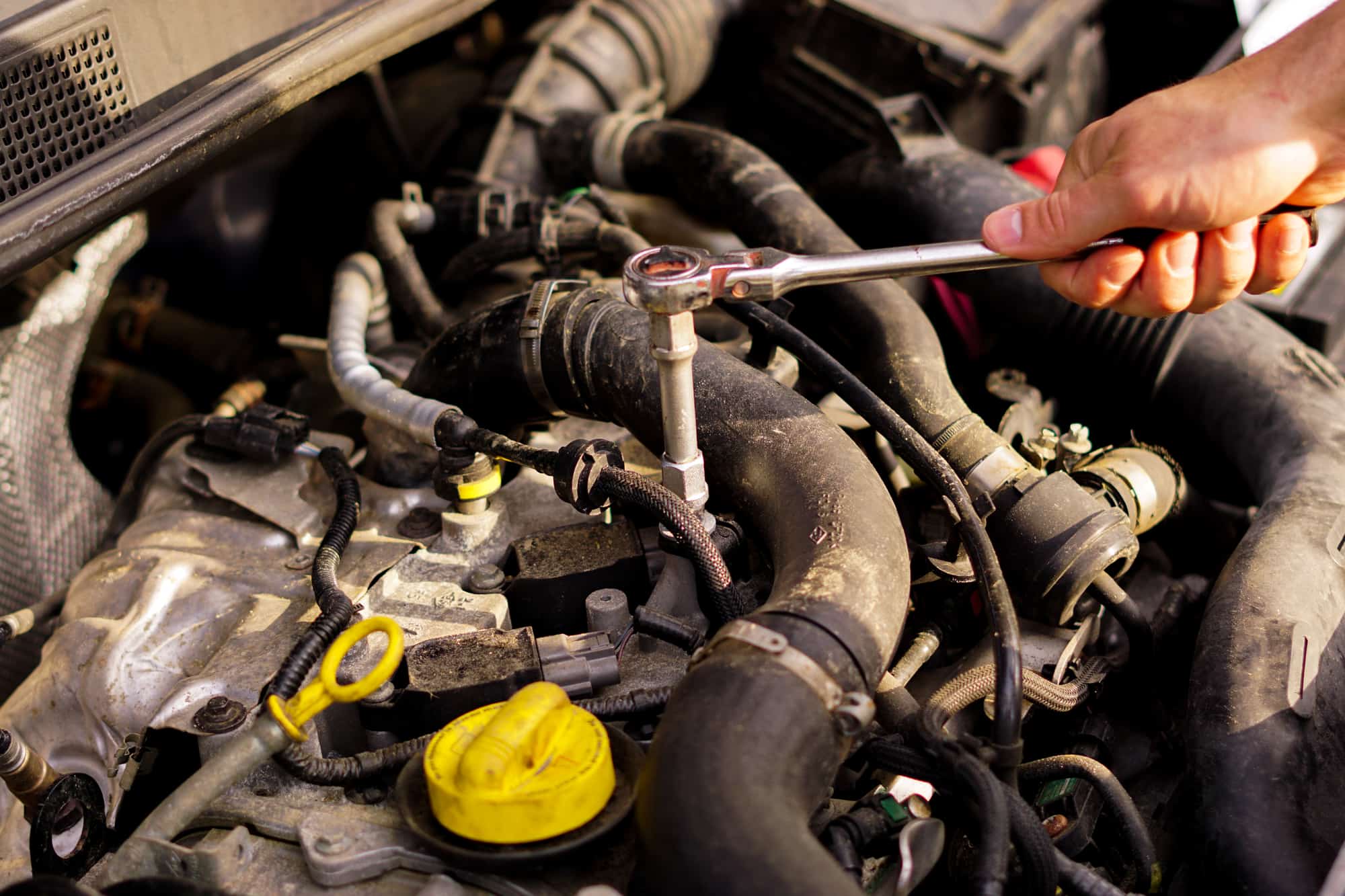The check engine light is a warning signal that something is wrong with your car, but it doesn’t always indicate a serious problem.
One of the more common reasons for this warning light to appear is an engine misfire. Engine misfires can cause a plethora of problems, from decreased fuel efficiency to permanent engine damage. But what exactly is an engine misfire, and how is it linked to the check engine light?
An engine misfire occurs when one or more cylinders in the engine fail to ignite properly, causing a disruption in the engine’s normal firing sequence. This can be caused by a variety of factors, including faulty spark plugs, a clogged fuel injector, or a malfunctioning ignition coil.
As an Amazon Associate we earn from qualifying purchases.
While a single misfire may not seem like a big deal, it can quickly escalate into a serious problem if left unchecked. Engine misfires can cause a variety of symptoms, including rough idling, poor acceleration, and decreased fuel efficiency. The check engine light can help diagnose the problem, but it’s important to understand what causes engine misfires in order to fix them properly.
Can An Engine Misfire Trigger A Check Engine Light?
An engine misfire can trigger a check engine light because the engine control unit (ECU) constantly monitors the performance of the engine. When a misfire occurs, it disrupts the engine’s normal firing sequence, causing a decrease in power output and efficiency.
The ECU detects this issue by monitoring the engine’s sensors, such as the crankshaft position sensor and the oxygen sensor. These sensors provide information to the ECU about the engine’s performance, and when a misfire occurs, the sensors detect the problem and send a signal to the ECU.
The ECU then stores a diagnostic trouble code (DTC) related to the misfire, such as the P0300 code for a random or multiple cylinder misfire.
This triggers the check engine light to illuminate on the dashboard, alerting the driver that there is an issue with the engine. The DTC code can help a mechanic diagnose the problem and determine the root cause of the misfire. It is important to address the issue promptly to prevent further damage to the engine and to ensure optimal vehicle performance.
What Are Engine Misfires And What Are The Causes Of Check Engine Light Activation with Engine Misfires?
An engine misfire is a condition where one or more cylinders in an engine fail to ignite the air/fuel mixture during the combustion cycle.
This can lead to a variety of engine performance issues and can even result in serious engine damage if left untreated.
There are various causes of engine misfires, including issues with the ignition system, fuel system, and mechanical issues. Here are some of the most common causes:
| Cause of Engine Misfire | Description |
|---|---|
| Faulty spark plugs | Worn or damaged spark plugs can cause a weak or absent spark, leading to misfires |
| Failed ignition coil | The ignition coil generates the spark that ignites the fuel in the engine. A failed ignition coil can cause misfires |
| Clogged fuel injector | A clogged fuel injector can cause an imbalance in the air/fuel mixture, leading to misfires |
| Faulty fuel pump | A failing fuel pump can cause a decrease in fuel pressure, leading to misfires |
| Vacuum leaks | Leaks in the engine’s vacuum system can cause an imbalance in the air/fuel mixture, leading to misfires |
| Low compression | Low compression in one or more cylinders can cause misfires |
| Faulty sensors or modules | Issues with sensors or modules that control engine functions such as fuel delivery or spark timing can cause misfires |
| Electrical issues | Wiring problems or a failing battery can cause misfires |
| Dirty air filter | A dirty air filter can restrict airflow to the engine, causing misfires |
What are the other symptoms of an engine misfire besides a check engine light?
In addition to a check engine light, there are several other symptoms of an engine misfire. Here are some common signs that you may be experiencing an engine misfire:
- Rough acceleration: You may feel a strong or light jerk coming from the engine when accelerating.
- Rough idle: The engine may feel like it’s shaking or vibrating when idling.
- Vibrations: You may feel vibrations throughout the vehicle, especially at higher speeds.
- Decreased fuel efficiency: An engine misfire can cause the engine to burn more fuel than necessary, leading to decreased fuel efficiency.
- Engine sound changes: The sound of the engine may change, becoming louder or more rough-sounding.
- Reduced power: The engine may feel like it’s lacking power or struggling to perform.
- Foul smell: You may notice a strong smell of gasoline or exhaust coming from the vehicle.
It’s important to address any of these symptoms promptly to prevent further damage to your car’s engine. If you are inexperienced in dealing with engine problems and symptoms, then it’s best to have a qualified mechanic diagnose and repair the issue.
What Is The Relationship Between The Check Engine Light and Engine Misfires?
The check engine light and engine misfires are closely related. When an engine misfire occurs, the engine control unit (ECU) detects the issue and stores a diagnostic trouble code (DTC) related to the misfire. This triggers the check engine light to illuminate on the dashboard, alerting the driver that there is an issue with the engine.
The DTC code can help a mechanic diagnose the problem and determine the root cause of the misfire.
What Diagnostic Trouble Codes Are Common With Engine Misfires?
When an engine misfires, it will usually trigger the Check Engine Light (CEL) on the dashboard and any corresponding diagnostic trouble codes (DTCs) will be stored in ECU memory.
This code can then be read with an OBD-II scanner, which can help identify the specific issue.
Here’s a table outlining some common diagnostic trouble codes (DTCs) associated with engine misfires:
| Diagnostic Trouble Code (DTC) | Description |
|---|---|
| P0300 | Random or multiple cylinder misfire detected |
| P0301-P0312 | Cylinder-specific misfire codes (e.g. P0301 for cylinder 1 misfire, P0302 for cylinder 2 misfire, etc.) |
| P0351-P0358 | Ignition coil primary/secondary circuit malfunction codes |
| P0201-P0208 | Fuel injector circuit malfunction codes |
| P0171-P0175 | Fuel system lean/rich condition codes |
| P0100-P0104 | Mass air flow sensor circuit malfunction codes |
| P0110-P0114 | Intake air temperature sensor circuit malfunction codes |
| P0120-P0124 | Throttle position sensor circuit malfunction codes |
It’s important to note that this is not an exhaustive list, and there may be other DTCs associated with engine misfires not included here. Additionally, the specific DTCs that are triggered may depend on the make and model of the vehicle.
The specific DTC code can give an idea of the cause of the misfire. For instance, if the code is P0301, it means that cylinder 1 is misfiring, and the cause could be a faulty spark plug, ignition coil, or fuel injector.
On the other hand, if the code is P0300, it means that the misfire is random, and the cause could be a vacuum leak, low fuel pressure, or a faulty sensor.
What Is the most common diagnostic error code associated with engine misfires?
The most common diagnostics code associated with engine misfires is the P0300 code, which indicates a random or multiple cylinder misfire detected.
Code P0300 is a generic diagnostic trouble code (DTC) that indicates a random or multiple cylinder misfire. When an engine misfires, it means that one or more cylinders fail to ignite the air-fuel mixture properly, resulting in a disruption in the combustion process. This can lead to poor engine performance, reduced fuel efficiency, and increased emissions.
When the ECU detects a misfire, it records the event and stores it as a diagnostic trouble code. In the case of a random or multiple cylinder misfire, the ECM cannot determine which specific cylinder is misfiring, so it assigns the P0300 code.
The ECM detects engine misfires by monitoring the rotational speed of the crankshaft, often using information from the crankshaft position sensor or other sensors. By analyzing the crankshaft’s rotational pattern, the ECM can identify irregularities that indicate misfires.
To diagnose the specific cause of the misfire, additional diagnostic procedures are typically required. The ECM may use various sensors, such as the oxygen sensors, mass airflow sensor, or fuel pressure sensor, to gather more information about the combustion process. This helps pinpoint the underlying issue, which could be related to ignition, fuel delivery, air intake, or other factors affecting the proper functioning of the engine.
In addition to the P0300 code, the ECU may also store cylinder-specific misfire codes (e.g. P0301 for cylinder 1 misfire, P0302 for cylinder 2 misfire, etc.) if the misfire is isolated to a specific cylinder.
However, the P0300 code is the most common code associated with engine misfires and is often the first code that is triggered when misfires occur.
Check Engine Light Flashing vs. Solid Illumination
When a check engine light illuminates on the dashboard, it can either be solid or flashing. A solid check engine light indicates a problem that needs to be addressed, but it is not an emergency. On the other hand, a flashing check engine light is an indication of a serious problem that requires immediate attention.
A flashing check engine light is usually accompanied by other symptoms such as rough idling, loss of power, or engine misfires.
A flashing check engine light is a common symptom of engine misfires. Engine misfires occur when there is incomplete combustion in one or more cylinders. This can be caused by a variety of issues such as faulty spark plugs, damaged ignition coils, or a clogged fuel injector.
When an engine misfire occurs, unburned fuel can enter the exhaust system, which can cause damage to the catalytic converter. This can result in expensive repairs if not addressed immediately.
If a flashing check engine light is accompanied by other symptoms such as rough idling or loss of power, it is important to pull over to a safe location and turn off the engine. Continuing to drive with a flashing check engine light can cause serious damage to the engine and other components.
Diagnosis And Repair of Engine Misfires And The Check Engine Light
The check engine light can comes on for many reasons, only one of which is engine misfires.
To get to the root cause of whats causing the engine misfires, you are going to need to use various diagnostic methods and tools.
Since every vehicle is different it would be impossible to outline the exact steps involved, so here is an overview of the steps involved in the general diagnosis and repair of engine misfires:
- Connect an OBD scanner: An OBD scanner is a device that can read the diagnostic trouble codes (DTCs) stored in the engine control unit (ECU). Connect the OBD scanner to the OBD port, which is usually located under the dashboard on the driver’s side of the vehicle.
- Turn on the ignition: Turn the ignition on, but do not start the engine.
- Retrieve the codes: Use the OBD scanner to retrieve the DTCs stored in the ECU. Look for codes related to engine misfires, such as the P0300 code for a random or multiple cylinder misfire.
- Diagnose the problem: Once you have retrieved the DTCs, use the code information to diagnose the problem. Some common causes of engine misfires include faulty spark plugs, a clogged fuel injector, or a malfunctioning ignition coil.
- Repair the issue: Once you have diagnosed the problem, repair the issue by replacing any faulty components or performing any necessary maintenance. Clear the DTCs using the OBD scanner once the issue has been resolved.
- Verify the repair: After repairing the issue, verify that the problem has been resolved by driving the vehicle and checking for any symptoms of engine misfires. Use the OBD scanner to ensure that the DTCs have been cleared and that the check engine light is no longer illuminated.
Additional Tests Used To Identify Engine Misfires
In addition to retrieving OBD error codes, there are several other tests that can be used to diagnose engine misfires. Here are some additional tests that a mechanic may perform:
- Compression test: A compression test can help determine if there is a problem with the engine’s internal components, such as the piston rings or valves. A compression test involves removing the spark plugs and using a compression gauge to measure the pressure in each cylinder.
- Fuel pressure test: A fuel pressure test can determine if there is a problem with the fuel delivery system, such as a clogged fuel filter or a faulty fuel pump. A fuel pressure test involves connecting a fuel pressure gauge to the fuel rail and measuring the pressure while the engine is running.
- Ignition system test: An ignition system test can determine if there is a problem with the ignition system, such as a faulty ignition coil or spark plug. An ignition system test involves using a spark tester to check for spark at each spark plug.
- Visual inspection: A visual inspection can help identify any obvious issues, such as damaged wires or hoses, that may be causing the misfire.
- Smoke test: A smoke test can help identify any vacuum leaks in the engine, which can cause misfires. A smoke test involves injecting smoke into the engine’s vacuum system and looking for any leaks.
It’s important to note that these tests may vary depending on the make and model of the vehicle, and that a qualified mechanic will be able to determine which tests are necessary to diagnose and repair the issue.
What Is The Cost Of Repairing Engine Misfires and Turning Off The Check Engine Light?
According to an article on InsuranceNavy, the cost of repairing engine misfires can range from $100 to $1000 depending on the cause of the misfire and the extent of the damage.
For example, replacing a faulty spark plug may cost between $40 and $150, while replacing an ignition coil may cost between $120 and $380. However, if the issue is more severe, such as a damaged engine, the cost of repairs can be much higher.
It’s important to note that the cost of repairs may vary depending on the make and model of the vehicle, as well as the location and experience of the mechanic.
Turning off the check engine light will depend on whether the underlying issue causing the misfire has been resolved. Once the issue has been repaired, the check engine light can be turned off using an OBD scanner.
As an Amazon Associate we earn from qualifying purchases.





I’ve noticed my car suddenly feeling rough while idling and an increased fuel consumption. I’m worried it might be misfiring. What’s the best initial step I should take to diagnose if my engine is misfiring?
What should I do if I notice a decrease in fuel efficiency along with my check engine light coming on, but there’s no noticeable change in the vehicle’s performance?